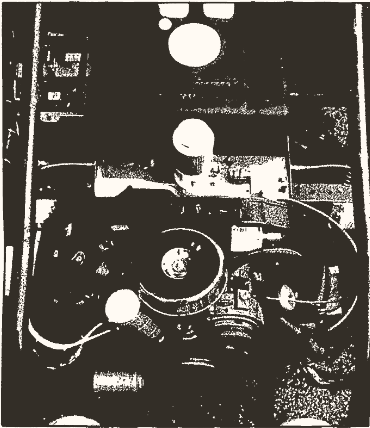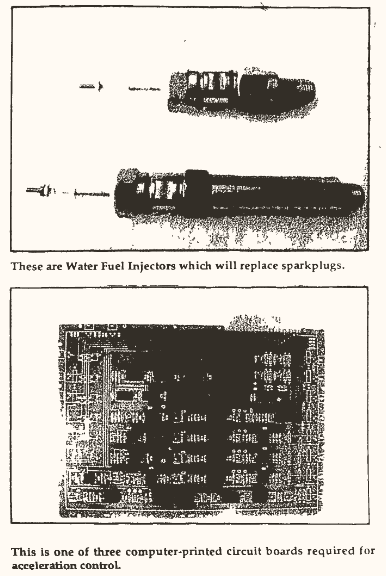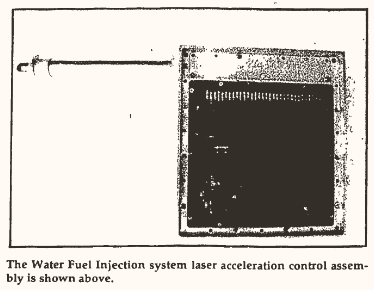Using water as fuel nears completion
By MARCIA THOMPSON
Grove City Record Editor
Source: https://grovecity.advantage-preservation.com/viewer/?k=&t=30203&i=t&d=01011901-12312011&m=between&ord=k1&fn=the_grove_city_record_usa_ohio_grove_city_19920916_english_1&df=1&dt=10
 Running a car on water is now several steps closer to reality than it was this time last year.
Running a car on water is now several steps closer to reality than it was this time last year.
Stan Meyer of Grove City, inventor of the Water Fuel Cell, a new technology that would allow vehicles and other internal combustion engines to run on water, has announced he recently received from the U.S. Patent Office a foreign grant license to allow full release of the Water Fuel Injector System® to go into the international marketplace, including the United States.
Meyer is currently finalizing systems engineering and says he owns all designs and development rights on the revolutionary alternate-energy system.
Since August, 1991, he has been filing and securing patents on systems processing and engineering designs, including four world patents. Two of these patents cover the method of operability—how and why the system works—design processing patents that give him full systems development rights. Two of these world patents are completed, and the last two are in the finalizing and production stages.
He said, “One covers a second important part of the Hydrogen Fracturing Process.” The first one covered the process, and the second one deals with the electronic circuit interfacing.
He has filed the Water Fuel Injection System® patents under the PCT Act (Patent Cooperation Treaty Act) with the World Patent Office in Washington, D.C. He stated there is a 20-month ruling to file in individual patent offices in countries around the world.
He says this is the greatest critical state he's gone through in the years he’s been developing the entire system. “If I violate the PCT Act, I’ve lost 15 years of work,” he stated.
“The object of these filings is to be able to bring out the Water Fuel Injector System® unilaterally—and bring it out to the entire world,” Meyer said. “All countries in the world have the same energy problems as the United States. The fossil fuel supply is running out, and alternate sources have to be found.”
“I had to go into full systems engineering in order to protect the technology and bring it into the international marketplace without receiving a technological blockage,” Meyer explained.
Meyer feels he has to control the technology personally to assure that he has the scientific backing.
“Very seldom do inventors have a chance to get into the systems engineering of their inventions,” Meyer said.
Water-powered car of tomorrow is on Grove City streets today
In the meantime, Meyer is required by the U.S. government to comply with all national security laws since his invention affects the military and the national economy.
“If these laws are violated, an inventor could be jailed,” Meyer explained.
“We’re now de-bugging the systems for reliability and performance,” Meyer said. “This is all done to secure the systems development rights of the international patents.”
He also had to design an update of the laser distributor with a two-stage signaling control and stage the timing of the high resonant pulse frequency voltage potential to be applied across the water in the Water Fuel Injectors that replace standard spark plugs. This not only runs the car, but gives it acceleration under controlled means.
Meyer is now in the miniaturization phase of his work. He said it costs $1,000 to develop the original Resonant Cavity technology which converts water to gas and controls the rate of gas flow on acceleration. The system is too large and costly to be adaptable or retrofitable into conventional vehicles, so Meyer is reducing the component through miniaturization for cost-effective production.
Meyer said we need to stop pulling oxygen out of the air, as current engines do. He says his technology uses oxygen from the water—not the air.
“A $2.50 recycling tube built into the system will allow auto manufacturers to convert vehicles which are currently creating air pollution,” Meyer said. “The gas is recycled through the system, so no air pollution occurs.”
"The number one area to reverse our environmental pollution problem is to convert internal combustion engines to run on water," Meyer said.
He recommends using rainwater with the Water Fuel Injection technology because it would be more free of contaminants, but says that water from other sources can be used if it is filtered. A filtration system is designed within the Water Fuel Injection System® to take care of this problem.
"I can see the old-fashioned rain barrel coming back into fashion," predicts Meyer.
The same filtration system can be transferred to all gasoline processes, Meyer says.
"The bottom line is that because of the Water Fuel Cell technology, we can convert any internal combustion engine or diesel engine and place it into the Water Fuel Injection System®," said Meyer. "It can be applied to cars, airplanes, blast furnaces, heat systems, and industrial processes. This would reduce the industrial foundation of every country in the world and reduce our reliance on fossil fuels as energy sources."
Meyer said the industrial base of countries must be maintained because without an energy supply, those bases would collapse quickly. "Our food supply would be quick disrupted."
Meyer's WFC system is designed to be retrofittable into any existing, regular fossil-fuel system. He says it will cost about $1,500 for the average-size car when it's mass-produced.
Meyer has presented his technology to scientists in seminars around the world.
"It stuns me that in all of the international conferences I’ve been since 1989, and in talking to the world’s scientific leaders, no other technology has emerged that has the design-retrofittable capabilities of the Water Fuel Cell Injection System® and there's no projection of alternative systems being proposed. That’s why I’ve been talking to world leaders and scientists on this technology, and that’s why this little old lab in Grove City, Ohio is becoming famous worldwide."
Meyer said he promotes in all the conferences he attends, that the WFC technology must be brought in throughout the world in one accord to prevent technological blockage.
"My greatest concern is how to get the technology into other countries to benefit all people," he says.
In the past year, Meyer has been named to Who’s Who of American Inventors and Entrepreneurs in the United States. He has had articles published in several national and international publications, including "raum & zeit US," "raum & zeit Europe," and "Explore. New Dimensions, Vol. 3, No. 4, 1992." He has addressed many conferences and seminars, including the 1989 International Congress for Free Energy in Switzerland, the 1990 International Extraordinary Science Convention in Colorado Springs, Colorado, and the 1991 International Global Science Congress in Daytona Beach, Florida.
"The credibility on the WFC technology is astronomically high," Meyer said. He spoke to 75 leading scientists in Geneva, Switzerland last November in a public forum. "They said it is viable technology," he said. "When I've secured all the registration and certification of the full systems design, I’ll be one very happy man," Meyer says. "After that, we're ready to go into the mass-production stage."
Many international patent licensing agreements are being negotiated throughout the world to decentralize both the manufacturing and installation of the Water Fuel Injection System® and related Water Fuel Cell technology. Hopefully, this phase of project completion will be bridged relatively quickly since many nations are responding to the urgent need to supply an alternative energy source to each respective economy.
"Environmentalists, on the other hand, are realizing that 'water as fuel' could possibly reverse our pollution problems relatively quickly if global usage becomes the accepted norm, since the combustion by-product of the combustible gases of water is water mist for hydrogen reuse," Meyer said.


